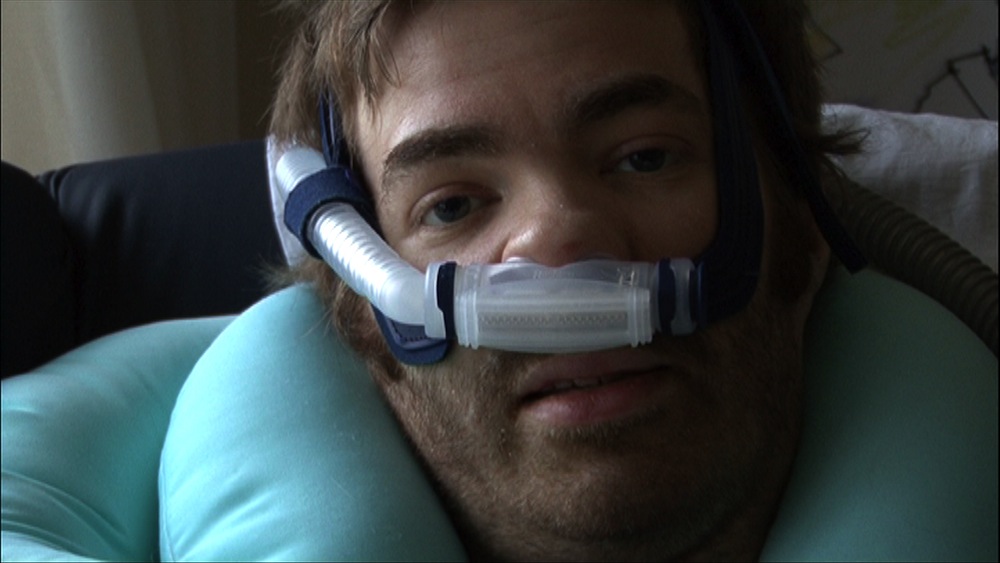Film Shows One Man's Battle with Lou Gehrig's Disease

Over the course of a year, Neil Platt went from being a healthy 33-year-old husband and father, to a man paralyzed by a rare, fatal disease. In a film about the final months of his life, Platt provides a heartbreaking, at times amusing, and startlingly honest view of what it means to be alive.
In February 2008, Platt, an architect in England, was diagnosed with amyotrophic lateral sclerosis (ALS) – also called motor neuron disease (MND), and Lou Gehrig's disease. He and his wife, Louise, started a blog to keep family and friends informed of the disease's progression.
The documentary "I AM BREATHING," which makes its United States premiere this weekend, tells Platt's story through his blog posts. The film will be shown Sept. 6 to 12 at the IFC Center in New York, and Sept. 13 to 19 at Laemmle Music Hall in Los Angeles.
Living and dying with ALS
ALS is a progressive neurodegenerative disease in which motor neurons, the cells that carry signals from the brain to the muscles, deteriorate and die. Patients lose voluntary muscle control, resulting in paralysis, loss of speech, and ultimately death. [The Top 10 Worst Hereditary Conditions]
Platt's blog entries, written with the aid of voice recognition software, serve as the film's narration and give viewers a glimpse of his experience.
"It's amazing how adaptable we are when we have to be," Platt says in the film. "It's what separates us, and defines us as human beings."
Sign up for the Live Science daily newsletter now
Get the world’s most fascinating discoveries delivered straight to your inbox.
As the disease progressed, Platt lost the ability to walk, control of his body from the neck down, and finally the ability to swallow. His inexorable decline is painfully paralleled by the burgeoning of his 1-year-old son, Oscar.
Louise Platt cared for her husband, a physically exhausting endeavor. But the most difficult part for them both was the emotional aspect, Louise said. "We changed very quickly from being husband and wife, to patient and carer," she told LiveScience. "It was great Oscar was around, because it kept us together as a family," she said.
In the blog, Neil Platt's commentary ranges from profound musings on life and death, to amusing quips about his everyday experiences. His first symptom of the disease was feeling his right foot slapping on the ground. Six months after his diagnosis, his hands stopped working; nine months later, he lost control of his legs.
Even as Platt lost control of his body movements, he continued to have sensation. Having minor itches and not being able to scratch them was one of the worst parts of his gradual paralysis, but facing the loss of speech was the most difficult, he says.
At one point, he writes a letter to his son, describing his university days, studying architecture, getting into trouble with friends, and falling in love with Louise.
Platt also makes a "memory box" for Oscar with significant objects from his life, such as his favorite leather jacket, which he wore while riding a motorcycle.
Making the film
Platt used his blog not only to communicate with family and friends, but also to raise awareness and funding for ALS. He did interviews with newspapers, TV and radio stations to inform people about the disease, in the hope that it might one day lead to a cure. [The 9 Most Bizarre Medical Conditions]
The idea for the documentary came from Platt, said Morag McKinnon, a friend of the Platts' who directed the film along with Emma Davie. "There are a lot of ethical dilemmas in terms of filming someone who's suffering and dying," McKinnon told LiveScience. But after considerable thought, she decided to do it.
Davie described the horror she felt the first time she saw Platt paralyzed from the neck down, and the contrast between his helplessness and his baby son's vigor. But Platt was determined to do it.
"I think [Platt's] ambition was to raise awareness about ALS," Davie said, "but as time went on, he was facing death, and could communicate something about being alive."
Platt relied on a ventilator to help him breathe for his last few months, but he specified in his advance directive that the ventilator be removed when he became unable to speak. He writes in his blog that "The ability to communicate has to be the strongest, most powerful freedom."
Platt died on Feb. 25, 2009.
More than 5,600 people in the U.S. are diagnosed with ALS yearly, according to the ALS Association. As many as 30,000 Americans may currently have ALS.
Platt was one of 5 to 10 percent of patients with a heritable form of the disease; his father died of the disease in his 50s. This form is caused by genetic errors passed from generation to generation.
Doctors don't know what causes the remaining 90 to 95 percent of ALS cases. No cure or treatment exists that can stop or reverse the disease.
Follow Tanya Lewis on Twitter and Google+. Follow us @livescience, Facebook & Google+. Original article on LiveScience.

Flu: Facts about seasonal influenza and bird flu
What is hantavirus? The rare but deadly respiratory illness spread by rodents










